Finding the right bike from the bars back
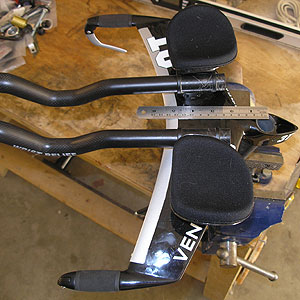
I have a problem. I need to road test 3T's new Ventus. This aero bar has the stem included as part of the integrated unit. So, no choosing my own stem length. Nor the pitch. No wiggle room when it comes to aero bar tilt.
Of course, I could've just slapped the thing on any bike, ridden it, and wrote about it. The problem is, I believe in the ultimate utility of a proper bike fit. The top of my saddle is 79cm from, and its nose even with, the bottom bracket. I hold the ends of the aero bars 80cm from the saddle's nose, and my armrests sit 15cm below the top of my saddle. How can I really determine whether I like this Ventus if it's not on a bike providing me my proper position?
All well and good in theory, but since the stem length and pitch are non-negotiable on the Ventus, and since the elevation between the armrest and the handlebar clamp is fixed (well, the elevation that would be there if there was a handlebar clamp), I have to find the perfectly sized frame for this aero bar.
I have to find a frame such that, when I clamp on this bar, it matches exactly my fit parameters. If I can't find that frame then, yes, I can write about the Ventus, and about how it's got its tannins in check and about its nose of berries and a hint of marzipan, but I'll be blowing smoke up skirts and I'll know it and the most discriminating among you will know it.
So, no, I can't do that. I must find the right frame and obtain it. Then I can road test this bar, and then the test will be valid. But how do I find this frame? I asked myself this very question, scratched my head, and then remembered I had a fit system.
My first task was to determine precisely the parameters of this Ventus bar. What was the stem length? The pitch? Where were the aero bar pads oriented, in both the X and Y axis, relative to where the handlebar clamp would be, if there was one?
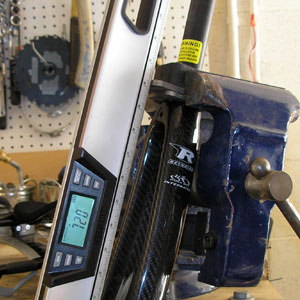
I placed a fork steerer into my miter block, and stuck that into my bench vise, angled it all at 72 degrees, and started measuring lengths and pitches and elevations. I stipulated that the backs of the armrests of the Ventus were 6cm behind the theoretical intersection with the handlebar (this setback is typical of most aero bars), and then measured from this point back to the center of the stem clamp. This gave me a theoretical stem length of 100mm.
I put the handlebar config most closely resembling the Ventus on my fit bike, complete with the same extensions in the same length. Yes, the extensions in this Ventus are not those that come with it. The Ventus I was sent had straight bars, and I don't like straight bars. Fortunately, the one modular aspect of the Ventus is its ability to accept any extension as long as the O.D. is 22.2mm, which seems to be the industry standard by consensus. I slapped some Blackwell Wrist Reliefs in the Ventus, and I can already tell I'm going to like that set up, assuming there's a bike under that bar I can ride that puts me in *my* position.
The Ventus' "stem" is pitched parallel to the horizon, so I put a 100mm minus -17 degree stem on my position simulator, aka my "fit bike." I set up the saddle height, seat angle, cockpit distance, armrest drop, and so forth, to match my fit coordinates. Thusly set up, the "bike" under that simulator is the bike I'm looking for.
Well, sort of. There was one fudge. The Ventus has 5cm of elevation difference between the armrests and the virtual handlebar clamp. My fit bike's Visiontech armrest and clamp system has 3cm of vertical displacement between these points. So, when I divined the mystery bike's stack and reach, I simply subtracted 2cm from the stack of the bike I was searching for, to make up for the 2cm difference in armrest elevation.
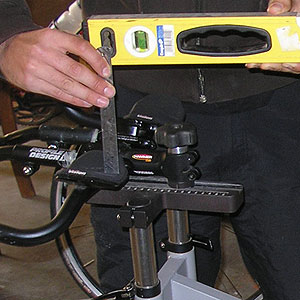
So, what is the magic bike? The stack and reach of the frame I need in order to ride this bar is 55cm and 44cm respectively (my position simulator states these numbers right on the unit once it is positioned to match my fit coordinates). At this point, I repaired to the trusty stack and reach tables and, voila, Cervelo P2C in 58cm is at 55cm and 44cm.
It's handy that it came out this way, since the CSC team rides both Cervelo and 3T. But this is not the only bike that works. Actually, a case could be made that the 58cm P3C is the better bike for me, at 53.5cm and 44.5cm. Why? Because this bike will fit assuming I place 15mm of spacers under the Ventus bar, to make up for the 15mm this frame is "too low." Why would I want that? Because our stack and reach tables are quite close, but they may be off by 5mm or 10mm here and there due to user error, and I'd like a little wiggle room. So, that 15mm of spacers is unnecessary if the stack and reach I've calculated is spot on, but if it's not, then the P3C grants me some insurance.
But isn't the P3C 5mm too long, you might ask? No, because the P3C's extra 5mm of reach disappears once you stack the bar up with 15mm of spacers (remember, you don't stack straight up when you put spacers under a stem, you stack up and back at 72 degrees or so of seat angle; you lose reach at a rate 30 percent of the height you stack).
Felt's 58cm bikes have a stack and reach of 54.5cm and 45cm. So, they're a very close fit, just 1cm too long, and if I slide those Wrist Relieve extensions 1cm back the bikes will fit me perfectly, except the armrests will ride 1cm further up my forearm. Of course, I would not be able to ride the Felts with the Bayonet fork, since those have stems integrated into the fork, so we end up with dueling integrated stems trying to put a Ventus on a Bayonet.
Giant's Trinity Alliance in size L has a stack and reach of 54.8cm, and 45cm, that is, this bike in L is almost identical to the Felts in 58cm. So, it would work. A Kestrel Airfoil Pro is, in 59cm, identical to the P2C in 58cm, at 55cm and 44cm of stack and reach. The Kuota Kueen K in size 58cm has the P3C's stack in 58cm, so that would work, but like the Felt and the Giant is about 1cm too long in the reach.
Leader's LD735TT in size 60cm has a stack and reach of 55cm and 44.5cm. QR's Kilo and Tequilo in 58cm is close at 54.5cm and 45.5cm, but those QRs are 15mm too long, for me, with this bar, and that makes these bikes just a little too long for this particular experiment.
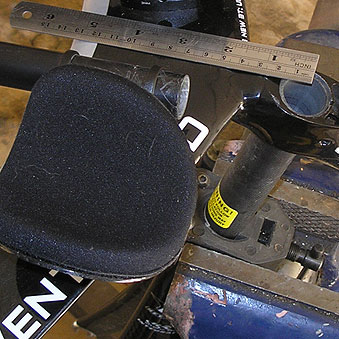
There are plenty of bikes, then, that would work. There are also several bikes I'd have liked to ride with this bar that I just could not. I thought I could kill two birds by test riding the Specialized Transition and the Ventus, but the S Works in XL has a stack and reach of 52.7cm and 42.5cm respectively. This frame, with this bar, for me, is both too low and too short. I also looked at the Cannondale Slice, a frame I admire. The 58cm is promising with a stack of 54.8cm but, alas, the rach is 41.7cm, more than 2cm too short.
This doesn't mean I can't successfully ride the S Works or the Slice. I just couldn't ride them with this bar. I'd probably ride the Slice in its 60cm size because I need that bike's longer reach, but it's also got a taller stack. I'd ride it with a bar that had lower elevation armrests, like the Profile Design Sonic Stryke or the Hed one-piece.
All this is to say that integrated bars like the Ventus take some planning. If you think you'll just buy this sexy bar and ride off into the sunset, well, you can, but then you'll be extolling its virtues to your friends, going on about the smoke and vanilla with overtones of licorice and cassis but in fact you've simply purchased poorly. As good carpenters say, measure twice, cut once. My advice: measure twice, buy once, especially with $1200 bars like the Ventus.
I'm very much looking forward to riding this aero bar, because I love its plush armrests and it seems quite ergonomic. But you won't be reading the road test until I get a bike underneath this bar that'll work for me. I'm further down the road of writing that review, since I now have the list of the bikes in the sizes that will work.


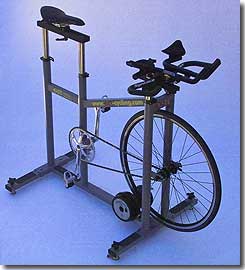
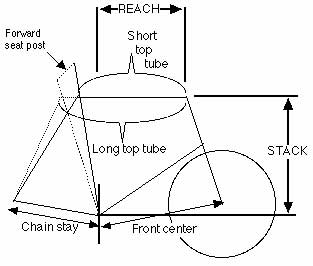
Start the discussion at slowtwitch.northend.network